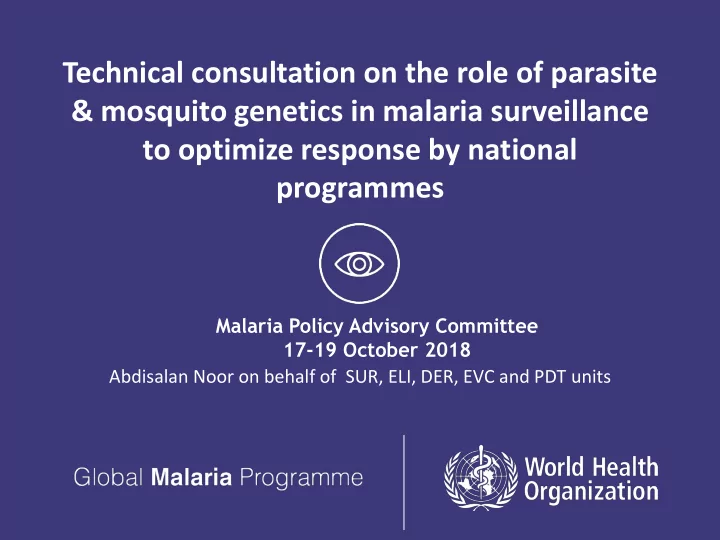

Technical consultation on the role of parasite & mosquito genetics in malaria surveillance to optimize response by national programmes Malaria Policy Advisory Committee 17-19 October 2018 Abdisalan Noor on behalf of SUR, ELI, DER, EVC and PDT units
Malaria surveillance in GMP GMP surveillance Entomology, Drug efficacy & Epidemiology hrp2 deletions insecticide efficacy resistance & resistance GMP/SUR GMP/EVC GMP/DER GMP/PDT GMP/ELI Parasite Vector Genetics and molecular epidemiology
Malaria surveillance in GMP
Parasite and anopheline genomics
Malaria genomics Neafsey & Volkman (2017) As the transmission intensity decreases from high to low levels, changes in mosquito (entomological inoculation rate [EIR]; human complexity of infection [COI]), and parasite (genotyping) indicators are anticipated to change. With relatively high transmission (e.g., EIR > 1), there are high COI levels and a predominance of polygenomic infections as assessed through genotyping methods. As transmission decreases to more moderate (e.g., EIR from 0.1 to 1) or lower levels (e.g., EIR from 0.01 to 0.1), decreases in COI are detected and increases in the proportion of individuals harboring monogenomic infections. Eventually as transmission intensity is very low(e.g., EIR from 0 to 0.01) evidence of COI = 1 and clonal parasite populations among monogenomic infections are detected using genotyping methods.
Potential use cases Area Use Genetics Resistance Parasite 1. Drug resistance markers 2. Insecticide resistance markers Mosquito Parasite 3. Drug resistance gene flows 4. Vector speciation Transmission intensity 5. Vectorial capacity Mosquito 6. Complexity of infections Parasite Elimination 7. Identification of foci Parasite 8. Identification of imported cases Parasite 9. Transmission chains Parasite
Resistance gene flow Amato R, Pearson RD, Almagro-Garcia J, Amaratunga C, Lim P, Suon S, Sreng S, Drury E, Stalker J, Miotto O, Fairhurst RM, Kwiatkowski DP (2018). Origins of the current outbreak of multidrug-resistant malaria in southeast Asia: a retrospective genetic study . Lancet Infect Dis . 2018 Mar;18(3):337-345 Spread of dihydroartemisinin – piperaquine resistance to north Cambodia (A) Each point represents a sample from northern Cambodia. (B) Genome-wide neighbour-joining tree of all samples from northern and western Cambodia in the dataset, with those carrying plasmepsin 2-3 amplifications identified by black dots at the tip. The circular subpanels show a magnified view of parts of the tree containing samples from northern Cambodia carrying plasmepsin 2 – 3
Mapping transmission intensity
Mapping transmission intensity
Micro-geographic structures of parasite populations Irene Omedo, et al (2017). Micro-epidemiological structuring of Plasmodium falciparum parasite populations in regions with varying transmission intensities in Africa. Wellcome Open Research 2017, 2:10 Kenya, Kilifi Gambia Kenya, Rachuonyo
Parasite genetics to identify malaria importation Neighbour-joining tree of Plasmodiium falciparum populations. Prefixes of genomes indicate parasite origins: Green text indicates parasite populations from the Democratic Republic of the Congo (DRC); orange indicates parasite populations detected in soldiers who were returning from the DRC to Guatemala; red indicates parasite populations from Guatemala.
Vectorial capacity ‘Variation in vectorial capacity for human malaria among Anopheles mosquito species is determined by many factors, including behavior, immunity, and life history .’ ‘This variation in vectorial capacity suggests an underlying genetic/genomic plasticity that results in variation of key traits determining vectorial capacity within the genus.’
hrp2 & 3 deletions
Challenges • Insufficient discourse between genomics researchers and policy making processes • Few joint genetics and epidemiological analyses to ease translation of results to policy/operations • Complex and diverse methods and limited national capacity, insufficient representative samples • Unresolved ethical, regulatory issues in the collection, sharing and use of genetic materials • Lack of clear guidance on priority policy relevant research questions
Opportunities • Increasing number of demonstration studies • Growing acceptance that genomics can play a role in policy and programme decisions • Increasing investments in genomics epidemiology research • Improving sampling and analysis methods and expanding regional capacity • More clarity on the ethics of use of genetic materials
Potential use cases for technical consultation Drug resistance gene flow Transmission intensity Parasite gene flow Local transmission chains Identify foci of transmission Identify imported cases Hrp2 & 3 deletions Vectorial capacity Insecticide resistance
Objectives of proposed technical consultation 1. Review existing evidence across the use cases 2. Refine the use cases to prioritize studies 3. Identify key research questions relevant to policy and operational national programme activities in each use case 4. Discuss the role of WHO in the legal, regulatory and ethics space to set standards for study designs and access to data 5. Explore possibility of a global WHO data portal
Implementation March 2019 April 2019 Nov 2018 – Feb 2019 Reviews of existing TC jointly convened Report submitted to literature on use by SUR, ELI, DER. EVC MPAC cases and PDT
Recommend
More recommend